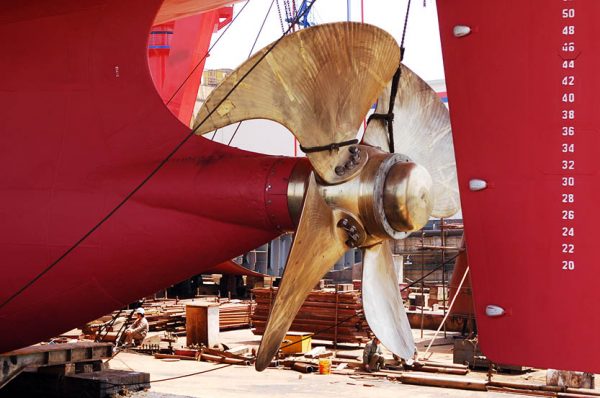Technical requirements
Suppliers and producers of installations and equipment often provide specifications pertaining to the technical requirements and compatibility of system components. Below, you will find an example of technical requirements of hydraulic fluids and lubricants, concrete release agents and other loss lubricants. These requirements were suggested by the Knowledge Centre for Environmentally-friendly Lubricants (KMS), which is part of the Dutch Department of Waterways and Public Works (RWS) as contract requirements. Other governmental services can also include these requirements in their specifications for building contractors or suppliers.
Hydraulic fluids
The product should meet the technical specifications as stated by VDMA 24568. The hydraulic fluid must be supplied in ISO-VG class 22 or lower. The kinematic viscosity at -200°C must not exceed 450 mm2/s. It must be proven in swelling tests according to DIN 53521 that the swelling of NBR rubber in the fluid concerned does not exceed 10%.
Lubricants, concrete release agents and other types of loss lubrication
The product must be suited to its application. The lubricant must meet the specifications of the equipment or installation which are provided by the manufacturer or supplier. The (maintenance) contractor may ask the manufacturer (OEM) to include ecological products in the manual or list of lubricants that are covered by warranty.
Ecolabels will also list technical requirements for lubricants. These technical requirements are employed because of quality considerations concerning life span and possible interaction with other system components. Distinction is made between lubricants in open and closed systems. The compatibility of lubricants and (parts of) the installation should always be determined in consultation with the suppliers (of lubricants and installations, vehicles, tools or equipment).
Sometimes exceptions need to be made when applying the Green Public Procurement criteria. Sometimes there is no ecolabelled alternative available for a specific application. In those cases, lubricants or additives that are necessary for technical reasons can be allowed, even though they may be hazardous to the environment.
In cases such as this, (bio)lubricants suppliers can be consulted on whether alternatives are available.
The Verband Deutscher Maschinen- und Anlagebau (VDMA) employs a classification of base oils, which distinguishes between mineral, vegetable and synthetic oils. The VDMA sheet lists the minimal preferred (technical) properties for the use of bio hydraulic fluids
Hydraulic fluids based on triglyceride (HETG) or ‘Pure Plant Oil’ (PPO) / ‘Straight Vegetable Oil’ (SVO)
The application of rapeseed oil is generally preferred. It has a limited liquid temperature range of 15°C to 70°C. The oil tank must not exceed a maximum temperature of 60°C. This oil has a relatively short life span, as its resistance to oxidation does not meet the DIN 51.587 standard. As the oil gets older, it may thicken. However, if the temperature is kept low, the oil can function in farming equipment very well. Vegetable oils provide excellent lubrication. Additionally, they mix well with mineral oils. The VDMA sheets allow a maximum water content of 0.1%. That is why placing driers in the installation is recommended. The recommended sealing compounds are Polyurethane, Acryl Nitrile Butadiene Rubber (NBR), Hydrogenated Nitrile Butadiene Rubber (HNBR) and Viton®. PPO/SVO lubricants are often suited to open, ‘low-tech’ applications; for more advanced high-tech applications, esters are preferred.
Ester-based hydraulic fluids (HEES)
These fluids can be mixed with mineral oils. Synthetic esters can withstand high temperatures and have good lubricating properties. Contamination with liquid must be avoided in order to prevent hydrolysis. That is why the installation of driers is recommended. The VDMA sheets allow a maximum water content of 0.1%. The biodegradability is excellent. This oil meets very high standards and its life span can be long. The best sealing materials are Acryl Nitrile Butadiene Rubber (NBR) to a maximum of 80°C and Hydrogenated Nitrile Butadiene Rubber (HNBR) and Viton® to a maximum of 120°C. Synthetic esters are not easily soluble in water. It is commonly used in hydraulic installations where leakages would pollute the soil. Synthetic esters can be produced from vegetable and animal oils, as well as from mineral oils.
Hydraulic fluids based on polyglycols (HEPG)
Polyalkylene glycols are copolymers of oxides of ethylene and propylene. They are usually mineral-based, and for that reason they are not eligible for a number of ecolabels. If there is a spill, the oil will completely dissolve in water and dilute indefinitely, i.e. the water’s surface will not be sealed by an oil film.
Polyalkylene glycols are not as biodegradable as esters, but toxicity is low. From an ecological point of view, it is often better to combat leakage than to leave it to disintegrate naturally, as they still have a serious impact on the environment. Polyglycols cannot be mixed with hydrocarbons, which are the base product for mineral oils. This means that they will not affect asphalt in the event of a leakage. If polyglycols were to leak onto concrete or onto an asphalt road surface, they could simply be removed with water. Apply caution around painted surfaces, as polygolycols can soften air dry paint. In contrast, two-component paint, and epoxy paint in particular, is wonderfully resistant. Polyglycols have good lubricating properties and can withstand very high temperatures. The maximum allowed water content is considerably higher than that of other hydraulic fluids; there is no need for driers. The VDMA sheets state a maximum water content of 2%. Preferred sealing materials are Acryl Nitrile Butadiene Rubber (NBR) for relatively low temperatures or Hydrogenated Nitrile Butadiene Rubber (HNBR) and Viton® at higher operating temperatures (up to 120°C).
